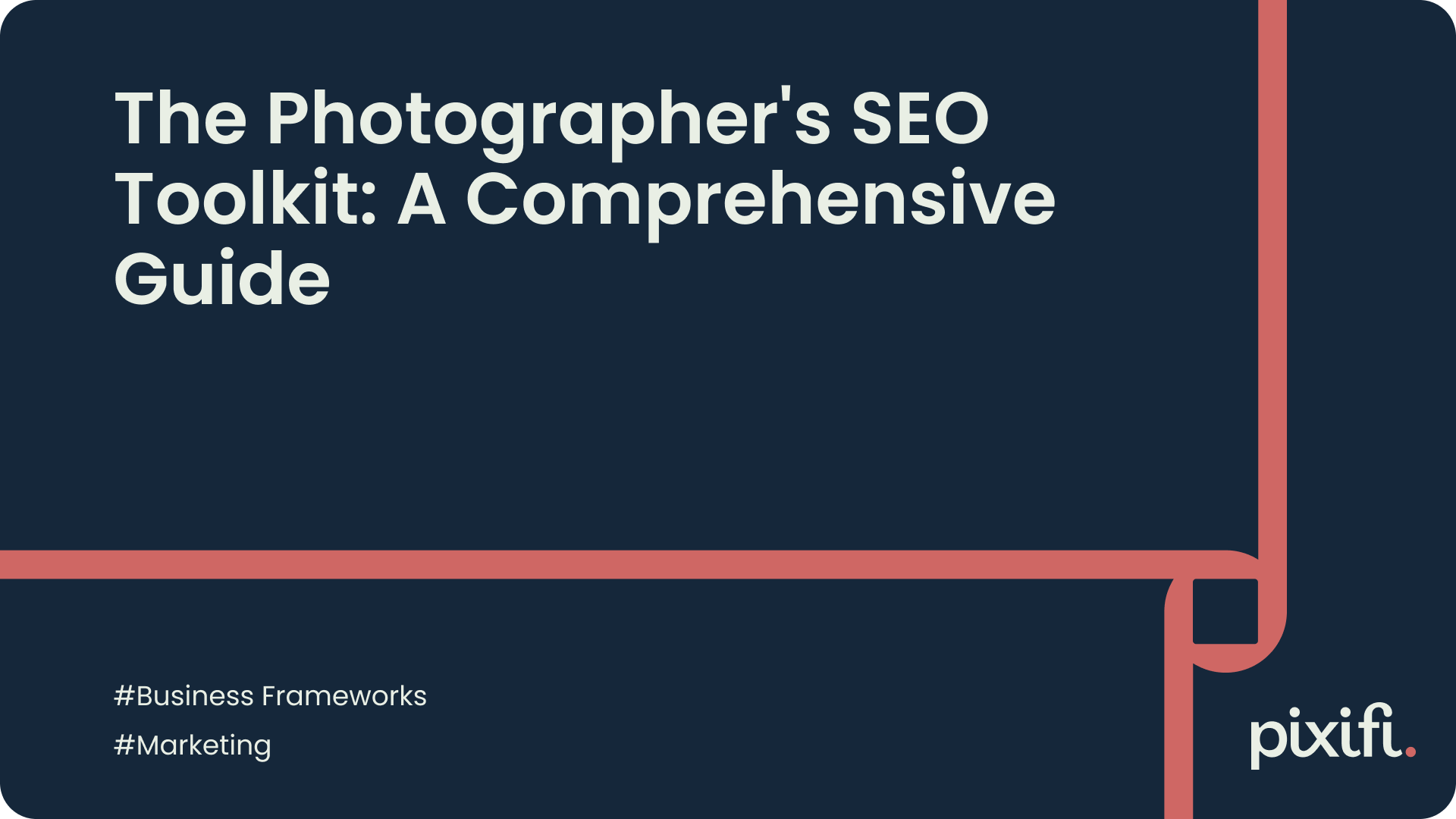Mastering Photography Business Management: Your Ultimate Handbook
Running a successful photography business is so much more than just taking great photos. Beyond mastering your craft, you need to know how to effectively manage the business side - the finances, marketing, operations, and legal aspects.
Without business management skills, some common issues photographers face include:
- Cash flow problems from financial mismanagement
- Overwhelm from disorganization and constantly "putting out fires"
- Loss of clients due to poor communication or service delivery
- Stress from trying to juggle too many things at once
Mastering business management allows you to put systems and processes in place to set up an efficiently-run and profitable photography business. This enables you to focus on your true passion - creating amazing photographs.
This handbook will provide photography professionals a blueprint to manage their business successfully. You'll learn how to:
- Create a business plan to align on your vision, objectives, and strategy
- Set up rock-solid financial structures and accounting practices
- Establish legal protections through contracts, permits, insurance
- Deliver 5-star service by wowing clients from first contact
- Streamline operations using smart workflows and automation
- Manage your brand, marketing, and growth systematically
- Leverage tools and resources to work smarter, not harder
With the strategies covered in this handbook, you'll gain the confidence and skills to manage a thriving photography business. Implementation is key - use this as your guidebook to put systems in place one step at a time until you have a well-oiled business management machine.
Let's get started with building a strong foundation, which is the first step on the path to success.
Building your Foundation
A solid foundation is key to building a thriving photography business. This involves defining your business plan, dialing in your finances, and establishing legal protections.
Creating a Business Plan
A business plan is like a roadmap that defines your business goals and how you will achieve them. It covers areas like:
- Business overview and objectives
- Products and services offered
- Target market and ideal client avatar
- Competitor analysis
- Marketing and growth strategies
- Financial projections
- Operations plan
Taking the time to create a comprehensive business plan has many benefits:
- It forces you to clarify your business vision, values, and goals
- You can spot gaps or weaknesses in your business strategy
- It keeps you focused and helps avoid scope creep
- You can use it to secure funding from investors or lenders
Set aside dedicated time to work on your business plan. Having a clear strategic plan is crucial to guiding your business decisions and measuring success.
Setting Up Financial Structures and Accounting
Solid financial systems and controls are essential for managing the financial side of your photography business. Key areas to focus on include:
- Accounting software - Choose a platform like QuickBooks to manage tasks like invoicing, expenses, payments, and taxes.
- Bookkeeping - Keep careful records of all income, expenses, assets, liabilities, and equity. Or outsource to a bookkeeper.
- Financial statements - Generate regular profit/loss statements and balance sheets to assess the financial health of your business.
- Cash flow - Use cash flow projections to anticipate income vs expenses. Maintain healthy cash reserves.
- Taxes - Understand tax obligations and work with an accountant to file business taxes correctly.
With robust financial systems, you gain clarity on the numbers. This enables you to make smart financial decisions to fuel growth.
Establishing Legal Protections
Taking steps to protect your business legally provides security and peace of mind:
- Business structure - Choose an entity like LLC that limits liability and provides tax benefits.
- Contracts - Use contracts to outline terms, conditions, scope of work, payment schedule, copyrights, and liabilities.
- Insurance - Secure general liability insurance plus errors and omissions insurance to protect from liability claims.
- Permits and licenses - Obtain all required local and state permits and business licenses for your photography business.
- Releases - Have photo release forms signed by clients and models giving you permission to use their images.
With the proper legal protections in place, you reduce risk and create confidence in your business systems.
Delivering Exceptional Service
Providing an incredible client experience is critical for photography businesses. Master these areas to wow clients:
Making Stellar First Impressions
A first impression has a lasting impact and sets the tone for the client relationship. Strategies for impressing clients from the start:
- Website - Have a professional website that displays your amazing work and is easy to navigate. Include your bio, services, and client testimonials.
- Portfolio - Curate an impressive portfolio that highlights your photography specialties and style.
- Consultation - Make consultations inviting. Discuss their needs, style preferences, and how you can bring value.
- Follow-up - Send a prompt thank you note after initial meetings reaffirming your enthusiasm to work together.
When you make clients feel understood, important, and delighted from the first interaction, you build instant trust and credibility.
Communicating Effectively
Ongoing communication is the lifeline between you and clients. Best practices include:
- Clarity - Be clear, direct, and transparent in all communication. Set proper expectations.
- Timeliness - Respond promptly to inquiries within 24 hours. Being responsive builds reliability.
- Professionalism - Craft emails, contracts, and collateral with excellent spelling, grammar, and branding.
- Listening skills - Listen attentively to understand what clients want. Reflect back to ensure alignment.
With robust communication systems, you can provide the white-glove service clients seek.
Streamlining Systems with CRM
Using a customer relationship management (CRM) system can significantly enhance client service. A good CRM centralizes key information like:
- Contact details
- Communications history
- Booked sessions
- Billing details
- Notes and preferences
This provides easy access to every client detail in one spot. CRMs also automate workflows like email sequencing. This saves tons of time while delivering personalized service.
Delivering exceptional experiences consistently is the key to retaining happy clients and winning new ones through referrals. Master these areas, and your services will stand out.
Managing Your Finances
Managing the financial side of your photography business includes budgeting, pricing, invoicing, and cash flow management. Implementing strong financial practices will keep your business profitable.
Creating a Realistic Budget
An annual budget provides a spending blueprint for your business and helps you plan cash flow needs. Steps for budgeting:
- List expected income from photography sessions, print orders, etc. Be conservative.
- Estimate expenses like gear, rent, salaries, marketing, taxes, and more.
- Factor in ad-hoc expenses for upgrades, maintenance, etc.
- Establish monthly and annual budgets based on projected income and expenses.
- Review budgets regularly and adjust as needed.
Sticking to a budget prevents overspending and ensures you remain profitable.
Developing Profitable Pricing Strategies
Set pricing that captures the value you provide while generating sufficient profit. Ways to optimize pricing:
- Research industry rates in your area for comparison.
- Factor in all costs - time, gear, editing, overheads, taxes - and desired profit margin.
- Offer packages with tiered pricing for different products and services.
- Communicate value not just cost - showcase why your unique expertise warrants higher rates.
- Raise prices gradually over time as you gain experience and recognition.
- Offer discounts only for limited-time promotions, not permanently.
Profitable pricing is key to running a sustainable photography business.
Sending Professional Invoices and Getting Paid
Make invoicing and payment collection a seamless process:
- Send invoices promptly after a shoot. Include dates, items purchased, and payment terms.
- Accept secure online payments by implementing a payment gateway on your website.
- Follow up with friendly payment reminders before due dates for overdue invoices.
- Offer installment payment plans for large purchases if needed.
- Always follow through on collecting - this ensures you actually earn what you bill for.
With disciplined invoicing and collections, you maximize your photography earnings.
Streamlining Operations
Smooth business operations are vital for running an efficient and productive photography studio. Focus on these areas:
Implementing Efficient Workflows
Analyze your business processes to identify any bottlenecks or redundancies. Look for ways to streamline workflows using:
- Organization systems - Keep files, assets, archives orderly so work is easy to find.
- Checklists - Checklists prevent forgetting key steps and reduce mistakes.
- Automation - Automate repetitive tasks like resizing images, email sequences, post-shoot follow-ups.
- Collaboration tools - Use tools like Slack or Trello to collaborate with team members.
When workflows are optimized for efficiency, you get more done in less time.
Managing Projects Seamlessly
Juggling multiple client projects can be challenging. Use project management principles:
- Break down large projects into tasks and set timelines.
- Prioritize urgent tasks and stick to schedules.
- Use charts and dashboards to visualize project progress.
- Identify resource needs and allocate your team accordingly.
- Proactively communicate with clients and provide progress updates.
With organized project management, work gets delivered on-time and on-budget.
Coordinating a Cohesive Team
For studios with team members:
- Hire those aligned with your values and photography style.
- Conduct extensive training to instill excellence and consistency.
- Set clear responsibilities, expectations, and processes.
- Foster open communication and collaboration.
- Recognize achievements to boost morale and loyalty.
An engaged, tightly coordinated team allows your studio to provide amazing service at scale.
Growing Your Business
To attract a steady stream of clients, focus on crafting your brand, digital marketing, and networking:
Crafting Your Unique Brand Identity
Define what makes your photography business one-of-a-kind:
- Articulate your vision, values, personality, and photography style.
- Create visual brand assets like your logo, colors, and font that reinforce your brand image.
- Ensure your website, collateral, and marketing unify around your brand.
- Deliver a cohesive client experience that aligns with your brand values.
An authentic, clearly defined brand builds your reputation and visibility.
Executing Digital Marketing Strategies
Leverage digital platforms to connect with potential clients:
- SEO - Optimize your website and content with relevant keywords so you rank high in search engines.
- Social media - Share your work regularly on Instagram and Facebook. Use relevant hashtags and tagging.
- Content - Create educational blog posts and videos that connect with your target clients.
- Email - Send email newsletters with tips or promotions to build relationships and stay top of mind.
- Ads - Run Google/Facebook ads to get your brand in front of targeted audiences.
A multi-channel digital marketing strategy helps you continuously expand your reach and acquire clients.
Building Partnerships Through Networking
Partnerships provide symbiotic benefits:
- Attend industry networking events and conferences to connect with colleagues.
- Partner creatively with other photographers or wedding vendors.
- Cross-promote related businesses through co-marketing or guest blogging.
- Develop referral relationships - offer discounts for referred clients.
Strategic partnerships allow you to grow your reputation and client base.
Leveraging the Right Tools
Running a photography business is made infinitely easier with the right tools. Focus on core software platforms and educational resources.
Software Essentials for Photographers
Integrating the right software creates efficiency:
- Pixifi - Pixifi provides an all-in-one software platform specifically for photographers to run their entire business seamlessly. Key features include:
- Client management tools like CRM, contracts, and invoicing
- Streamlined workflow management from shoot to delivery
- Booking pages and calendar integrations
- Robust analytics and reports to spot trends and make smart decisions
- Adobe Creative Cloud - For editing photos, Lightroom and Photoshop are vital.
- Cloud storage - Store images securely in the cloud on platforms like Dropbox or Google Drive.
- Email marketing - Use email marketing software like Mailchimp to manage email newsletters.
Optimized software boosts productivity and profitability.
Valuable Educational Resources
Continuous learning helps you elevate your craft and business acumen:
- Books - Read classics like "Best Business Practices for Photographers".
- Podcasts - Tune into podcasts like 'Six Figure Photography’ while commuting or shooting.
- Online courses - Take courses on photography, editing, marketing etc.
- Conferences - Attend local and national photography conferences to get inspired and learn new skills.
- Facebook groups - Join groups like "Photography Business Owners Network" to connect and learn from peers.
Make learning a lifelong habit to constantly level up.
Conclusion
Running a successful photography business requires mastery of both your creative skills and business management abilities.
In this handbook, we covered the essential components of photography business management:
- Crafting a solid business foundation with your plan, financials, and legal protections
- Wowing clients by delivering exceptional service consistently
- Managing your finances through budgeting, pricing, and streamlined billing
- Optimizing operations with efficient systems, project management, and team coordination
- Growing your business by honing your brand identity and leveraging marketing strategies
- Making your work easier with the right software tools and education
Follow this roadmap one step at a time, focusing on the areas most needed in your business. Over time, you will notice photography business management becoming second nature.
This will provide you the freedom to focus on your true passion - capturing stunning visuals through your lens.
To help you get started, access the following free downloadable templates and guides:
- Sample Photography Business Plan
- Photography Pricing Calculator (and Benchmarks)
- Photo Shoot Checklist
- Client Intake Questionnaire
- Photography Marketing Plan Worksheet
We hope this handbook provides a blueprint to take your photography business management abilities to the next level.




